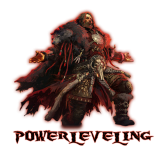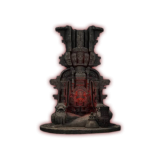PoE 2 Beginner's Guide: Getting Started in Path of Exile 2
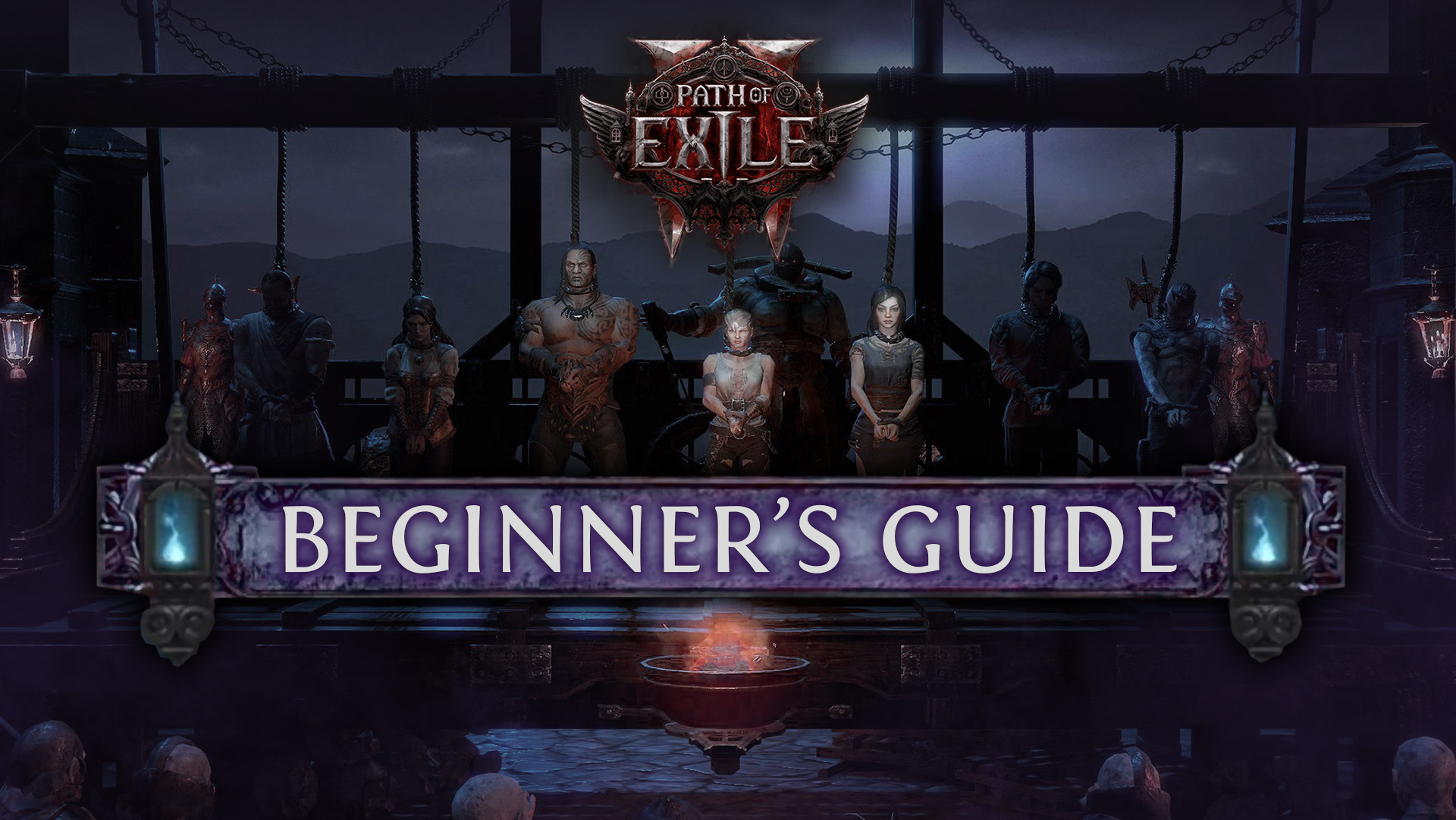
Greetings Exile. Welcome to our Path of Exile 2 Beginner's Guide!
PoE 2 is one of the most complex ARPG games on the market, with many finding it challenging to get started in this titan of the genre. Rest assured, in the following chapters, we will cover all the topics a newcomer to Path of Exile or ARPGs may need help with. Ready to get started in the world of Oriath? Let’s dive in!
Getting started in Path of Exile 2
Getting started in Path of Exile 2 is easy and straightforward. As soon as you launch the game and log in, you will be met with a character select screen, where you can see an overview of all your existing characters. If this is your first time booting the game up, you will have to create your first character, also known as “exile” through the game.
The second window that will come up is the game mode selection screen, where players can choose between Standard and the Temporary Challenge League. Additionally, players can opt-in for Softcore, which is the default game mode, SSF (solo self-found, trading with other players is disabled), Hardcore (dying will permanently delete your character), and Ruthless (a very punishing mode where loot is scarce). We will cover all these game modes in-depth later into the guide.
Moving on, you can now select your class. There’s a wide variety of classes to choose from, each with its own specializations. That being said, we will head into the next chapter, discussing the available classes and explaining ascendancies, alongside a list of the best classes for beginners, and tips & tricks on how to choose your starter class in PoE 2.
PoE 2 Classes & Ascendancies
Path of Exile 2 has one of the largest varieties of classes and playstyles through its ascendancy system. When creating your character, you can choose between 12 classes: Marauder, Warrior, Ranger, Huntress, Witch, Sorceress, Duelist, Mercenary, Shadow, Monk, Templar, and Druid.
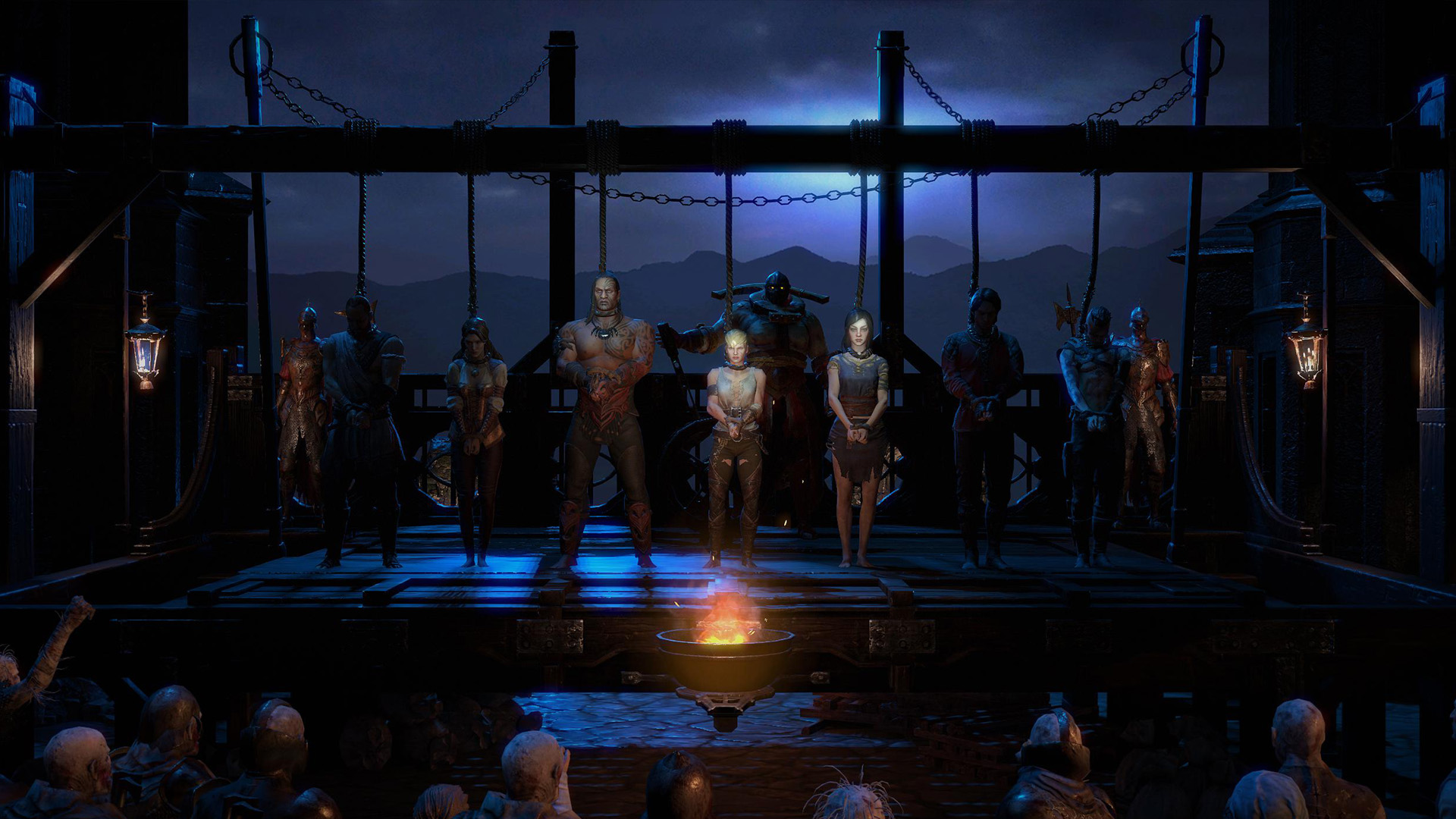
Additionally, each class is split into three different ascendancies. Ascendancies act like a specialization for the class, offering a miniature passive skill tree with unique modifiers and powerful effects. To unlock ascendancies, you must complete Ascension Trials, which are available starting with Act 2.
Classes in Path of Exile 2
Path of Exile 2’s classes work entirely differently than in any ARPG currently on the market. Instead of having a preset of skills available to each class, the only difference between them is the starting location on the passive skill tree, alongside their base stats. If you’ve ever wished to play a gunslinging witch or a spell caster warrior, with decent knowledge of the game or help from build guides, in Path of Exile 2 you can experience these unique build ideas.
The main deciding factor for the build archetype is the chosen ascendancy, which we will discuss in the following part of the guide.
Ascendancies
As mentioned previously, class ascendancies will unlock a small passive skill tree that focuses on a generalized type of effects, leaving room for creativity no matter which ascendancy you choose. We don’t have much information on the exact ascendancies of each PoE 2 class, but we do know that they will be more focused on a specific archetype than in Path of Exile 1.
Best class for beginners in PoE 2
You may ask yourself, what is the best class for a new Path of Exile 2 player? If this question has crossed your mind, we're here to answer it so you can begin your PoE 2 adventure smoothly. To make it easy for you to find the perfect class, this section of our guide will list the top Path of Exile 2 beginner classes.
Using the tier list below, our in-depth Path of Exile 2 class analysis will direct you to a character that provides an exceptional mix of excitement, adaptability, and accessibility:
| Tier | Class | Reason |
| S-Tier | Witch | Easy-to-play, minions deal most of the damage |
| Druid | Tankiness, powerful crowd control, and debuffs enemies | |
| Sorceress | Long range caster, ignite allows for accessible gameplay, freeze is a great defense layer | |
| Templar | Very tanky class, many easy-to-understand builds, doesn’t require powerful gear to shine | |
| A-Tier | Shadow | Resilient, easy-to-play, DOT & trap based gameplay |
| Marauder | Tankiness through ascendancies, great damage, many playstyles | |
| Warrior | Simplistic gameplay, high survivability | |
| Mercenary | Great endgame scaling, unique bow/crossbow gameplay, fun to play | |
| Duelist | Strong melee class, tankiness or damage option through ascendancies | |
| B-Tier | Ranger | Susceptible to oneshots in early game, best endgame scaling, great damage at all stages |
| Huntress | Melee/ranged hybrid, requires multiple skills | |
| Monk | Melee caster/attack hybrid, may require combos to deal optimal damage |
How to choose your starter class in PoE 2
Choosing the best class for starting out in Path of Exile 2 requires some research on your end, as classes don’t have that big of an impact on the build. Our best recommendation would be to check out a variety of builds and pick the one you like most, which will dictate the class. Otherwise, you can also pick out a class or ascendancy and check out builds until you find one that matches your playstyle.
Generally speaking, PoE 2 builds are straightforward to play, with most of them being one-button builds, having a single movement skill, and buffs that don’t require uptime unless you face challenging content in the end-game. There are also more complex builds, but the difference in power is minimal, so you don’t have to worry about an easier build being much weaker.
For more details on this topic, check out our PoE 2 class tierlists.
Moving forward, we will showcase some third-party tools, websites, or communities that will enhance your Path of Exile 2 experience. Some of them may not be available on release, but rest assured, the community will update them as soon as possible. All the following are 100% safe and within GGG's ToS, so your account is not at risk as they provide no advantages in gameplay.
Third-party Tools for Path of Exile 2
In this section, we will cover a variety of PoE 2 third-party tools that will assist you in your journey through Oriath, helping you with crafting items, planning or checking out builds, pricing items or entire stash tabs, and even third-party communities for trading items or services in bulk.
Craft of Exile
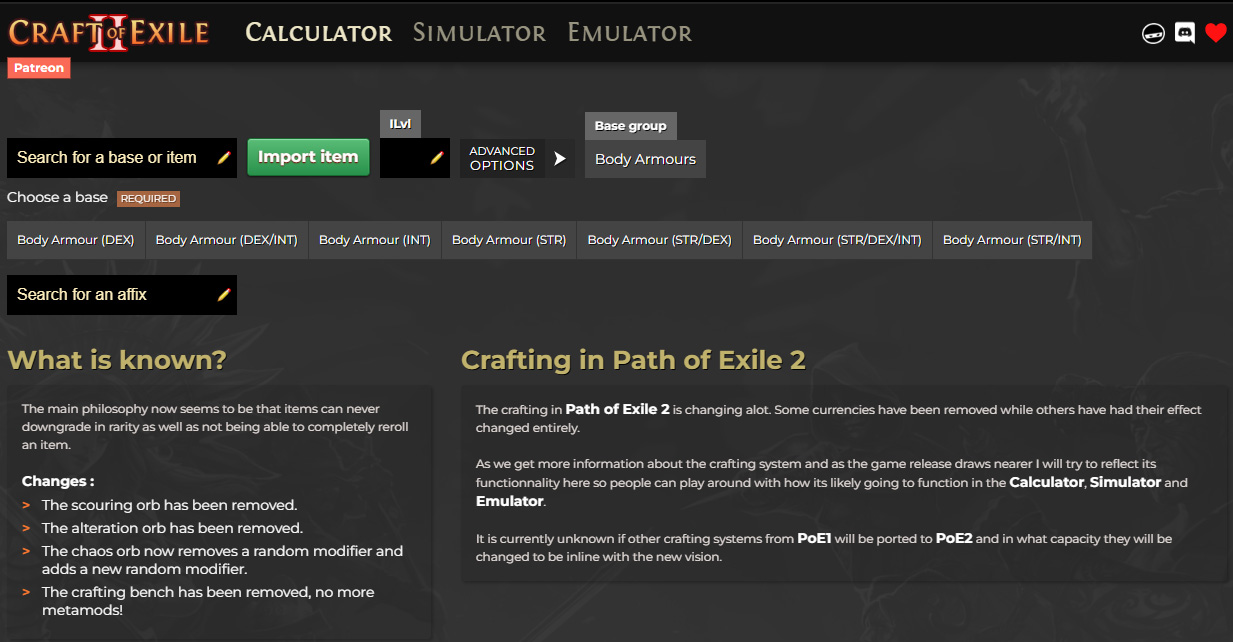
Craft of Exile is a compendium for anything crafting-related in Path of Exile 2. The website offers a variety of tools, from a crafting simulator and price calculator for various crafts to lists of modifiers with their weight for each item type. It’s essential to master this tool to increase your crafting knowledge, and they also provide accessible guides on each feature of their website.
Path of Building
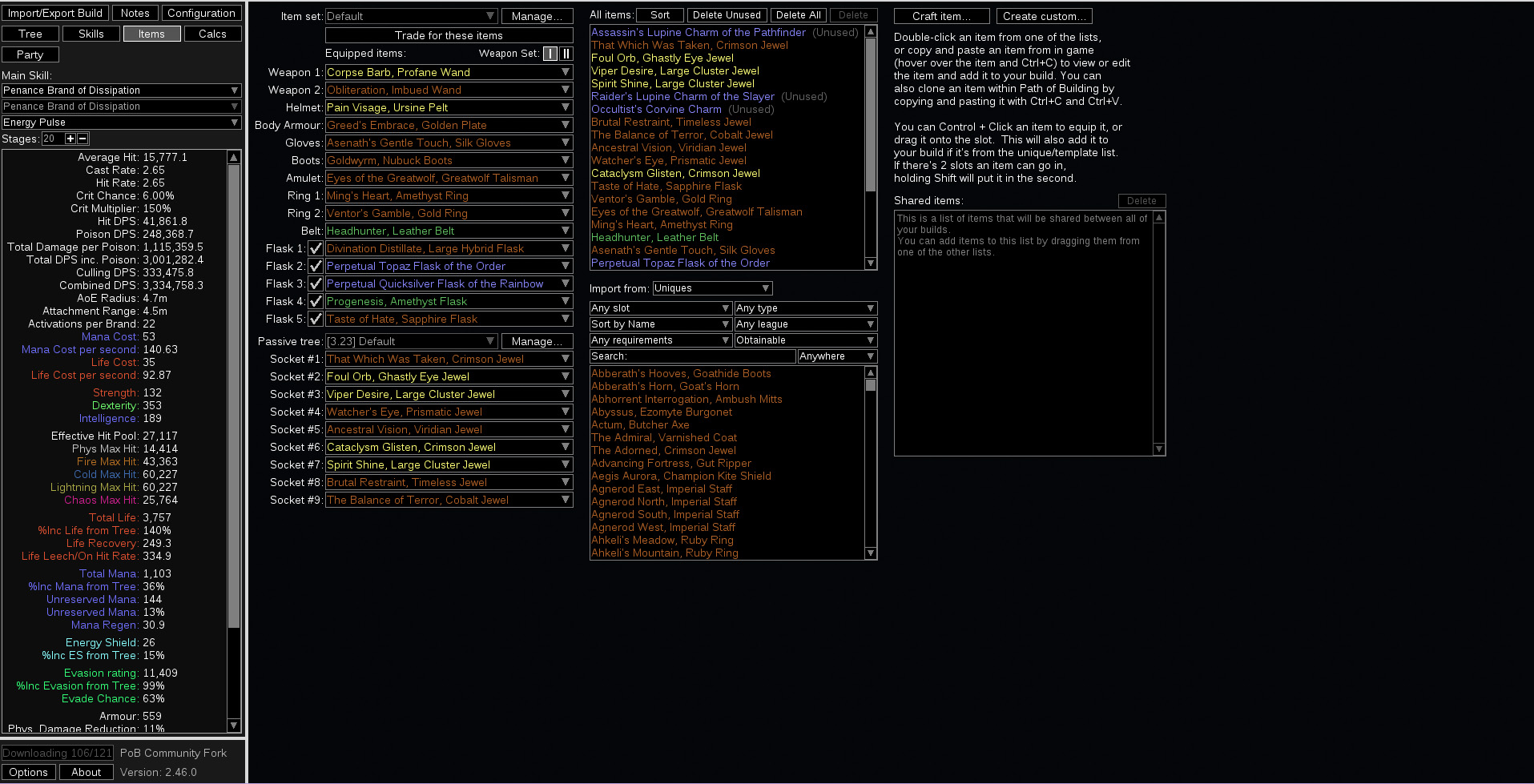
Out of all the tools listed in this chapter, Path of Building is the most essential tool to master, as it is used to share builds in any available build guide on the internet. The in-game stat calculator often leaves out many buffs and effects, so the stats and DPS values shown in-game frequently differ from the actual numbers.
This tool perfectly incorporates that, allowing you to customize your build for any scenario and accurately represent your stats, resistances, eHP, and DPS.
Exilence
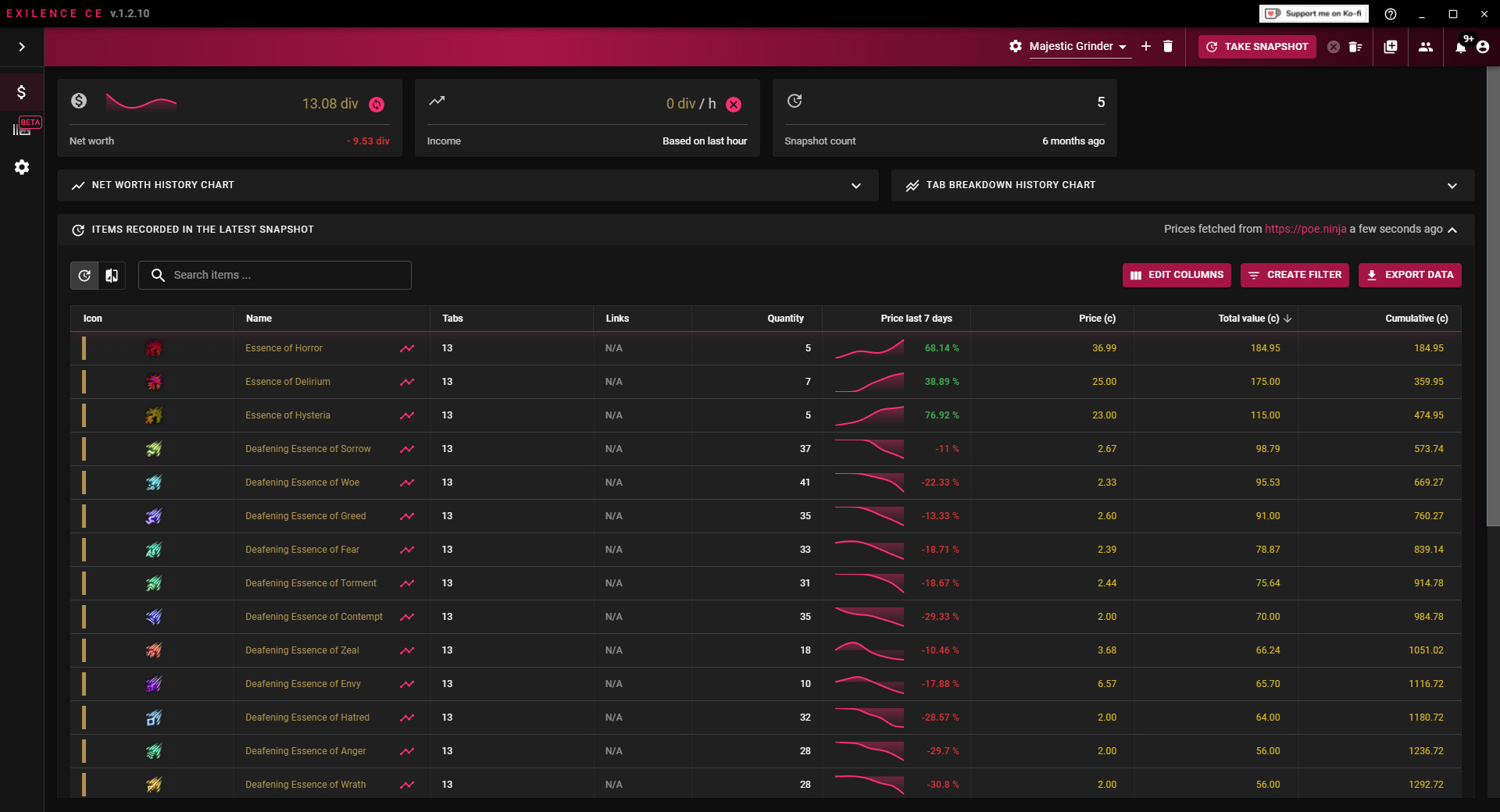
Exilence is another helpful tool developed by the Path of Exile community. This tool assists players in tracking their grind session & pricing entire stash tabs at once. Since everything in Path of Exile relies on currency, it is useful to be able to track the value of all the items you obtain during your grind so you can always know how far along you are on your way to buying a new item or unique for your build.
Awakened PoE Trade
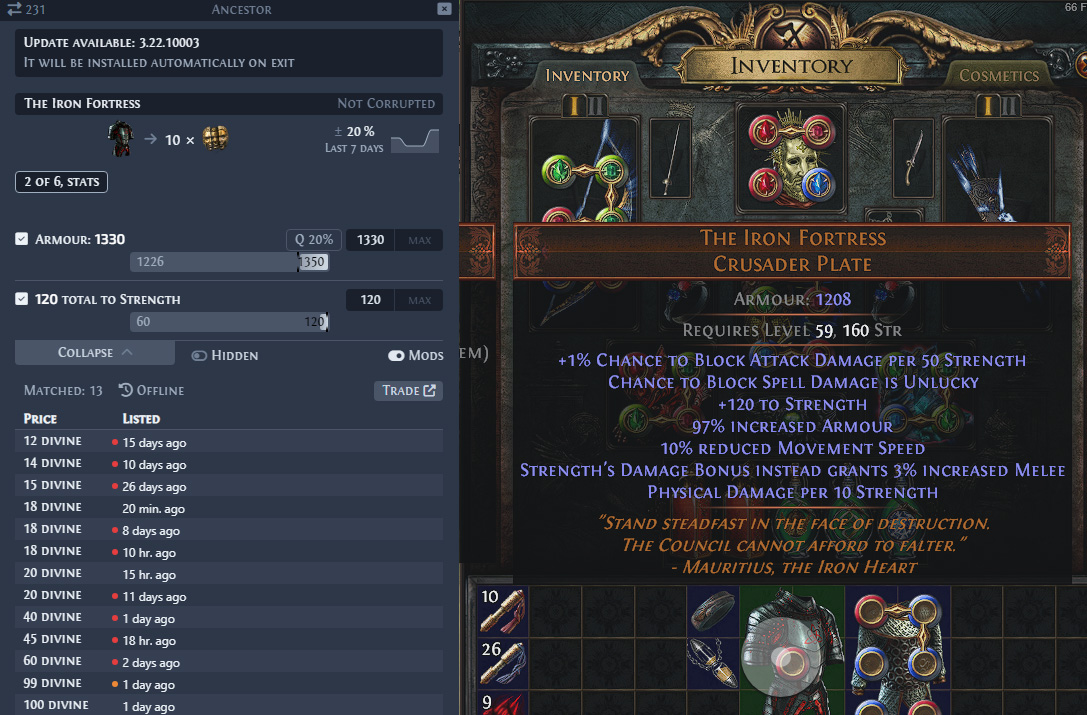
While Exilence is the master tool for pricing currency & consumables in bulk, it cannot price gear and uniques you own based on their stats. This is where Awakened PoE Trade comes in. This versatile tool allows you to check the price of any item on the go, working as an overlay. Additionally, it can help you create filters for sorting items in your stash tabs, or binding actions (like logout & exit) and text messages to a single key.
The Forbidden Trove
Last on the list is The Forbidden Trove, widely known as TFT by the PoE 2 community. TFT is a Discord server created by the Path of Exile community that facilitates selling and buying builds, trading currencies or consumables in bulk, or selling and buying services and crafts, all for in-game currency.
If you decide to play on a trade league, joining this discord server is a must, as it saves you a significant amount of time when trying to stock up on different currencies for a craft, buying maps in bulk, or selling the loot from your grinding session without having to go through the process of manually listing each item on the auction house.
Leagues & Standard in PoE 2
Path of Exile 2 is split into two main game modes: Standard and the Temporary Challenge League. Standard is similar to Legacy in Diablo 4, where it’s a permanent realm, while Challenge Leagues are similar to Diablo 4 & Last Epoch seasons, where everyone starts fresh. In the following subchapters, we will take a look at each one, highlighting the positives and negatives.
Standard
Standard is the base game mode in Path of Exile 2, which never has its progress reset and is generally less popular than Challenge Leagues. Generally speaking, we recommend Standard for players who do not have much time to play the game, as their progress remains there permanently. Additionally, suppose you like min-maxing to the extremes. In that case, Standard is also fit for you, as you can constantly work on your character without a time limit looming over a long time, or have access to “legacy” items.
Leagues
On the other hand, Leagues in PoE 2 are time-limited realms that last 3 to 4 months and introduce either new mechanics or rework systems already existent in the game. All players start fresh when a new League is released, offering an excellent experience for new and advanced players alike. Leagues are the best time to experience new builds and try things out, as the fresh economy allows you to follow the “normal” course of the game.
Best PoE 2 league starter builds
Choosing the best build for the start of a league depends on many criteria, and the meta is constantly shifting based on buffs, nerfs, and changes. Listing builds based on their strength would be a hard task as starter builds are created for specific activities, so we will instead list a few archetypes that are known to be great starter builds: Detonate Dead, trap builds, Boneshatter builds & Lightning Arrow.
Moving on, we will take a look at the additional "challenge modifiers" you can opt for when selecting your game mode.
SSF, Hardcore & Ruthless in Path of Exile 2
Solo self-found (widely known as SSF), Hardcore, and Ruthless are game mode options that players can opt in addition to selecting the Standard or League realm. Each one works in its own realm, so players playing in the Hardcore League can only interact with other Hardcore League characters. In the following three subchapters, we will showcase each, explaining the intricacies of each game mode.
SSF
In PoE 2, solo self-found players cannot trade items with other players. You can consider SSF as a single-player mode for the game, where you can only use items you find yourself. Despite sounding like a fun experience, this requires knowledge of many aspects of the game, so it is not recommended to start your first few characters in SSF.
Hardcore
Hardcore is the most punishing game mode out of all the available options. In Hardcore, you can interact and trade with players, but you must avoid dying at any cost. If you die in Hardcore, your character will be deleted or transferred to Standard. In this game mode, players focus on the defensive aspects of their build to be able to withstand any content without risking dying.
Ruthless
Ruthless, while less punishing than Hardcore, is also a very tough game mode. By opting in for Ruthless, the amount and quality of loot that drops will be massively lowered, which means slower and more challenging progression for your character. This forces players to make use of any resource available and can be a great throwback to ARPGs from the past, like Diablo 2.
Now that we’ve covered all the “preparation” steps and options available before hopping into the game, we’ll continue exploring the gameplay aspects, starting with leveling.
PoE 2's Campaign & Leveling
In Path of Exile 2, the campaign acts like a streamlined leveling experience that introduces a few of the game’s mechanics to you through it. Your character’s main source of experience is killing mobs, with the experience amount being determined by the level of the monsters.
Campaign Overview
PoE 2’s campaign consists of six acts, with each act taking you through a different zone of Oriath, experiencing the continuation of the story from Path of Exile 1 after Kitava’s fall. Each chapter takes around 3 to 4 hours to complete, and, as far as we know, the campaign is unskippable, so each time you create a new character you will have to clear all six acts again.
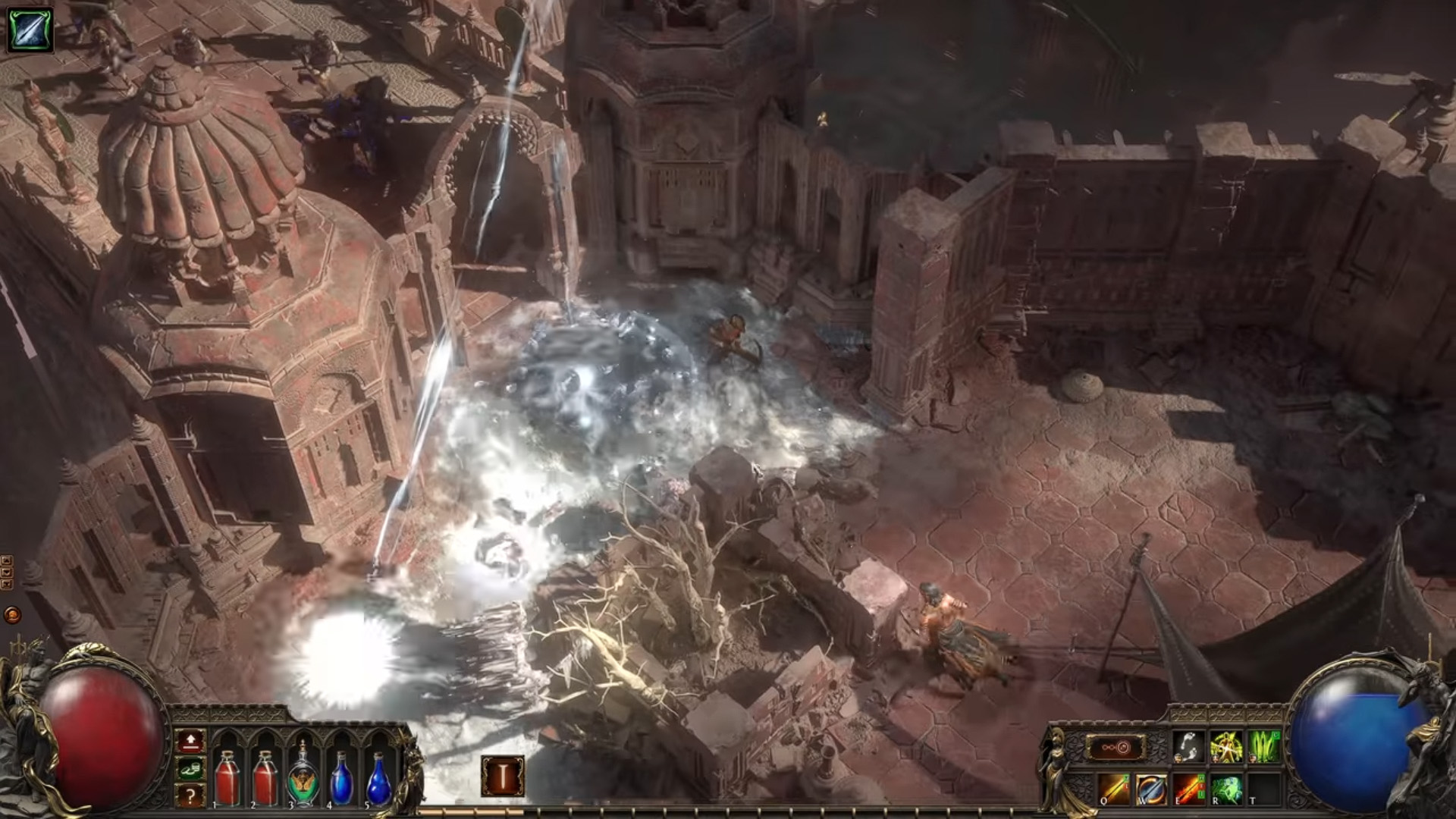
Rest assured though, every time you make a new character and go through the campaign, you will start learning the layouts of each zone and knowing what objectives must be completed, considerably speeding up your clear time. If your first time through the campaign took 30 hours, after 5-6 new characters, you’d be able to go through it in 10 to 12 hours.
How to level up fast in PoE 2
Since the main source of XP in Path of Exile 2 is killing mobs, leveling up quickly is directly tied to the mob level and density. In order to level up fast, we recommend killing any mobs you find on your way without looking for stragglers. Highly packed groups or mobs, and magic or rare mobs reward the highest XP reward, but you should not waste time trying to kill elites with modifiers that will make them hard to kill.
SKIP THE GRIND GET CHEAP POE 2 SERVICES!
When reaching the endgame, you will have multiple avenues to explore in your leveling process, while being as efficient as possible, which we will present in the following subchapter.
Best activities for leveling
Once you finish the campaign and gain access to the end-game, you will have access to maps, which are instanced zones that contain mobs, a boss, and various activities. Some activities can pack a huge amount of mobs, leading to massive XP gains in a short time. The ones that we recommend clearing if you want to maximize your experience gains are Breaches and Delirium Mirrors.
For more details on this topic, check out our PoE 2 leveling guide.
Moving on, the next topic is gearing, in which we will cover all the essentials you need to know about Path of Exile 2’s gearing system, and how to optimize your gameplay experience.
Gearing Up in Path of Exile 2
Gear in PoE 2, similar to many other aspects of the game, is a complex system. Rest assured though, we will keep this part of the guide simple and easy to understand even if you haven’t played Path of Exile 2 before, explaining all the important aspects.
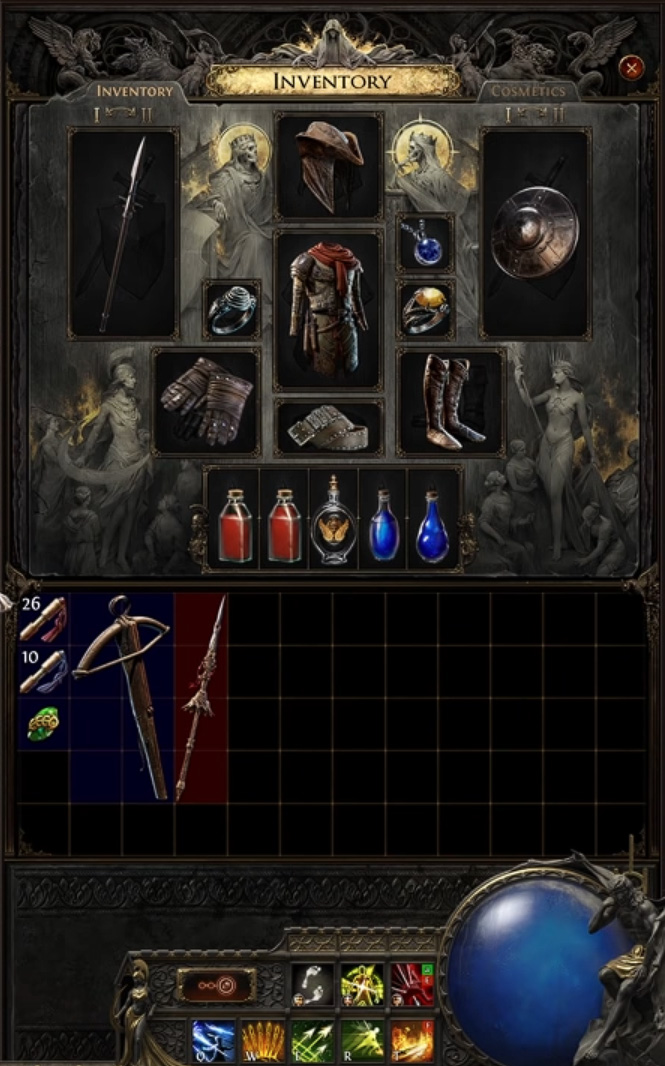
Gear can be split into two main categories based on their rarity: unique items and non-uniques ( composed of normal, magic, and rare items). Unique items come with several preset modifiers, and sometimes even modifiers exclusive to that item.
On the other hand, non-uniques can have up to 6 modifiers based on their rarity, which are randomly assigned out of a pool of modifiers that can roll on the items. Most builds in Path of Exile 2 use a combination of hand-crafted rare items and uniques.
When it comes to gearing up, during the campaign, your main source of equipment will be random drops from mobs or vendors in cities that offer items with affixes that are generally useful during the game’s early stages. Once you reach the endgame, most items you find on the ground will not be useful to you, so you will have to either trade with other players or craft your own gear.
Understanding Skill Gems
Skill gems are one of the defining aspects of Path of Exile 2. Instead of using a traditional system, where each class has its own specific abilities, they are instead found in the form of skill gems, which are equipable items that grant you the ability to cast said skill. Compared to gear, skill gems do not have modifiers, but they can be leveled by using Uncut Skill Gems.
Skill gems come in two types: active gems and support gems. Active gems grant players castable skills, while support gems can be socketed into active ones to increase their damage, alter their ability, or provide other increases in power for the main gem. Depending on the available number of slots, up to five support gems can be socketed in, with jeweler orbs being used to change the number of available sockets on a skill gem.
Understanding Flasks
Flasks are another essential aspect for your character in PoE 2 and can be divided into two types based on their effects: health flasks and mana flasks. These can be used on demand to restore a set amount of health or mana.
Compared to other games, flasks are permanent items that work based on a charge system. When you go to town, all your flask charges get refilled. Also, your flasks will gain a set amount of charges whenever you kill rare or magic mobs.
Additionally, flasks can have modifiers of their own, with general effects that vary from enhancing the effect of the flask, increasing duration, and making the flask more efficient regarding charges, by either reducing the amount of charges used, or increasing the amount of charges gained when killing elite mobs.
There is also a third type of item which works similar to flasks, known as Charms. Charms can block a certain type of crowd control from being applied to you and make your character immune to it for a short time afterwards when at max charges. Depending on your needs, you can equip three different charms in the available slots.
Resistances in PoE 2
The last aspect we will be covering about gear in Path of Exile 2 is resistances. Currently, the game has five types of damage: elemental (split into fire, cold, and lightning), chaos, and physical. Each of these damages can be mitigated by either elemental or chaos resistance and armor. Additionally, evasion works against attacks, allowing you to completely negate the damage taken, with the chance being based on your evasion rating.
Due to the way PoE 2 is designed, in order to comfortably clear content without feeling too squishy or dying a lot, it’s essential to equip gear pieces that grant you resistances. The values we aim for in every build are 75% for each elemental resistance, 0% or more chaos resistance, and around 80% physical damage reduction from armor, sometimes even combined with evasion.
Reaching these values will drastically increase your character’s survivability, and keeping track of your resists starting from the mid-point of the campaign is recommended.
For more details on this topic, check out our PoE 2 gearing guide.
Next, we will take a quick peek at the complex passive skill tree that Path of Exile 2 has to offer.
PoE 2 Passive Skill Tree
Path of Exile 2’s take on skill tree is one of the most innovative designs in the entire RPG genre, offering players a 1500+ passive skill tree arranged in the form of a web, which is shared between all 12 classes. There are 6 starting points on the passive skill tree, with 2 classes sharing each of the starting nodes.
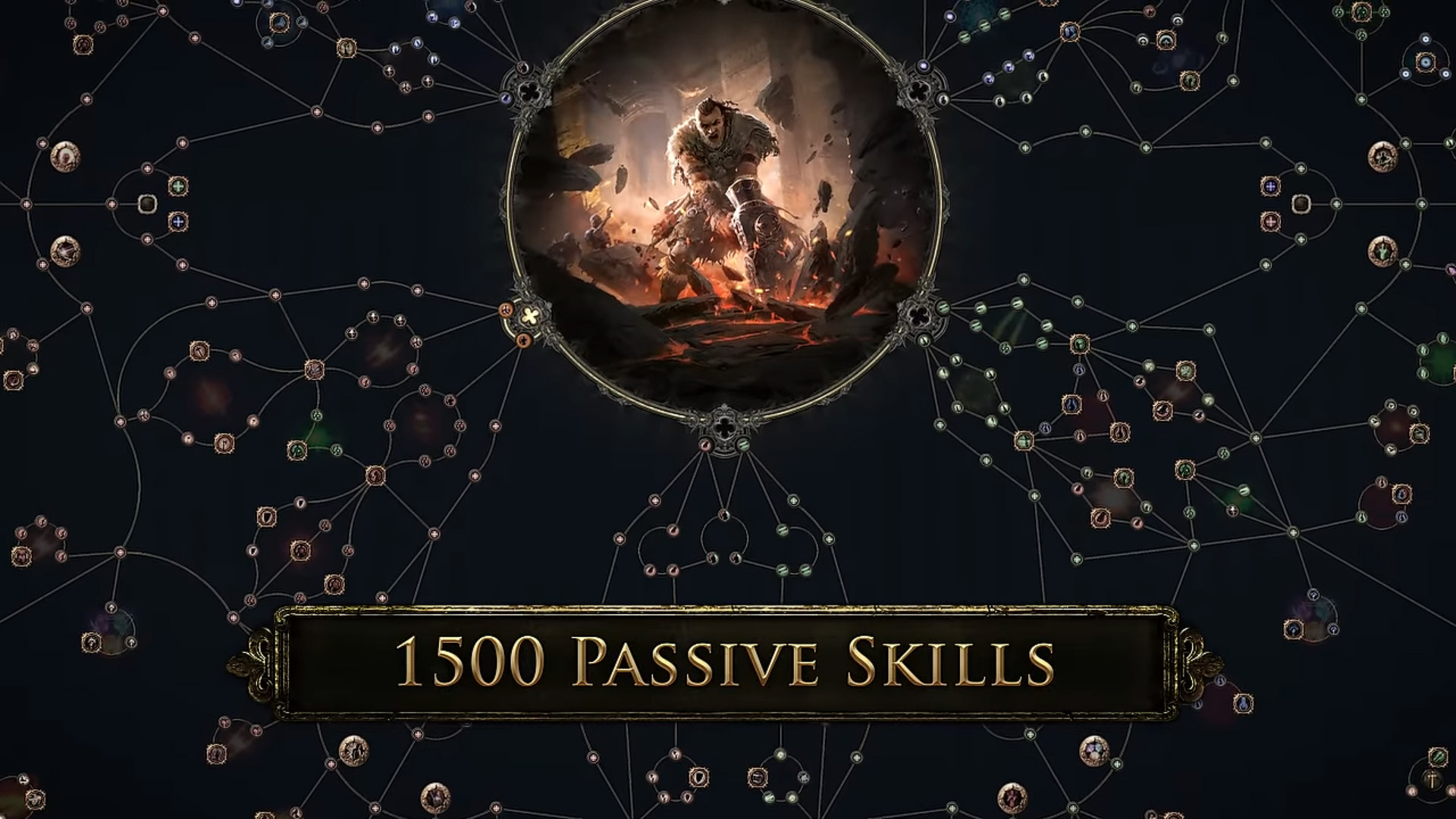
Each time you level up, you will gain a skill point, which you can allocate to any passive connected to either the starting point or previously allocated passives. Also, you can gain extra skill points by completing side quests you will find in each act from the campaign.
Passives on the skill tree are localized in clusters of three to six passives and come in two types: small passives and large passives. Each cluster has a specific theme, offering passives themed around a specific stat, such as armor, fire resistance, increased fire damage, etc.
While small passives give a minor increase to the stat, with no unique effects, large passives grant either a significant increase or completely unique effects related to the theme of the cluster. Additionally, if you spec into the large passive, you gain access to the mastery passive, which is a list of modifiers shared between all clusters of the same type, out of which you can choose one to your liking.
In the following chapter, we will cover the basics of crafting, one of the most fun and intriguing aspects of the game.
Crafting basics in Path of Exile 2
Path of Exile’s 2 crafting system is one of the most fun and interactive ways of gearing up your character. Each item’s power is defined by the affixes, which can be altered in multiple ways. Crafting can be summed up as using a variety of currency items in a specific order, mixing and matching these crafting materials, hoping to get a particular combination of affixes on your item. In most cases, each step requires multiple attempts, that means a fair bit of RNG.
Each affix (modifier) on an item has multiple tiers, affecting the minimum and maximum value of the stat the item can roll. The highest tiers or even specific modifiers are locked behind the item level of the equipment, so getting the best possible values will only be available on items dropped in the end-game.
For those interested in understanding how items are generated or how new affix combinations are chosen when crafting an item, we will briefly explain how this system works. Each item has a pool of modifiers with a specific value assigned to it. All these values are added up, and then a dice is rolled for each drop or craft, with the number rolled deciding each modifier and tier.
Based on all the currencies available in Path of Exile 2, we can generalize all crafting outcomes, with most items and systems either guaranteeing a specific modifier, increasing the chances of certain modifiers, reducing the chances of specific affix types, or even “banning” certain mods from appearing at all.
For more details on this topic, check out our PoE 2 crafting guide.
Up next, we’ll take meddle with the trading system in Path of Exile 2, delving into the various ways of exchanging items in the ARPG.
Trading in PoE 2
Trading is one of Path of Exile 2’s most essential aspects of the game for any non-SSF player. Generally speaking, most of your items, crafting currencies, supplies for farming in the end-game, and more will come from trading with other players.
In PoE 2, every item is tradable, even after being modified or crafted, allowing for exclusive ways of obtaining currency through crafting & selling items while giving access to players who are not as knowledgeable about crafting BiS items.
Trading in PoE 2 will have a complete overhaul, introducing an auction house that will allow players to instantly buy any stackable item listed. For other items, like pieces of gear, the system is fairly simple, requiring direct player interaction, through the trade window.
This is a major improvement compared to the first game's trading system, with the only gimmick being that you will require gold to complete any purchase, which is account-bound, and has to be hand farmed by killing monsters.
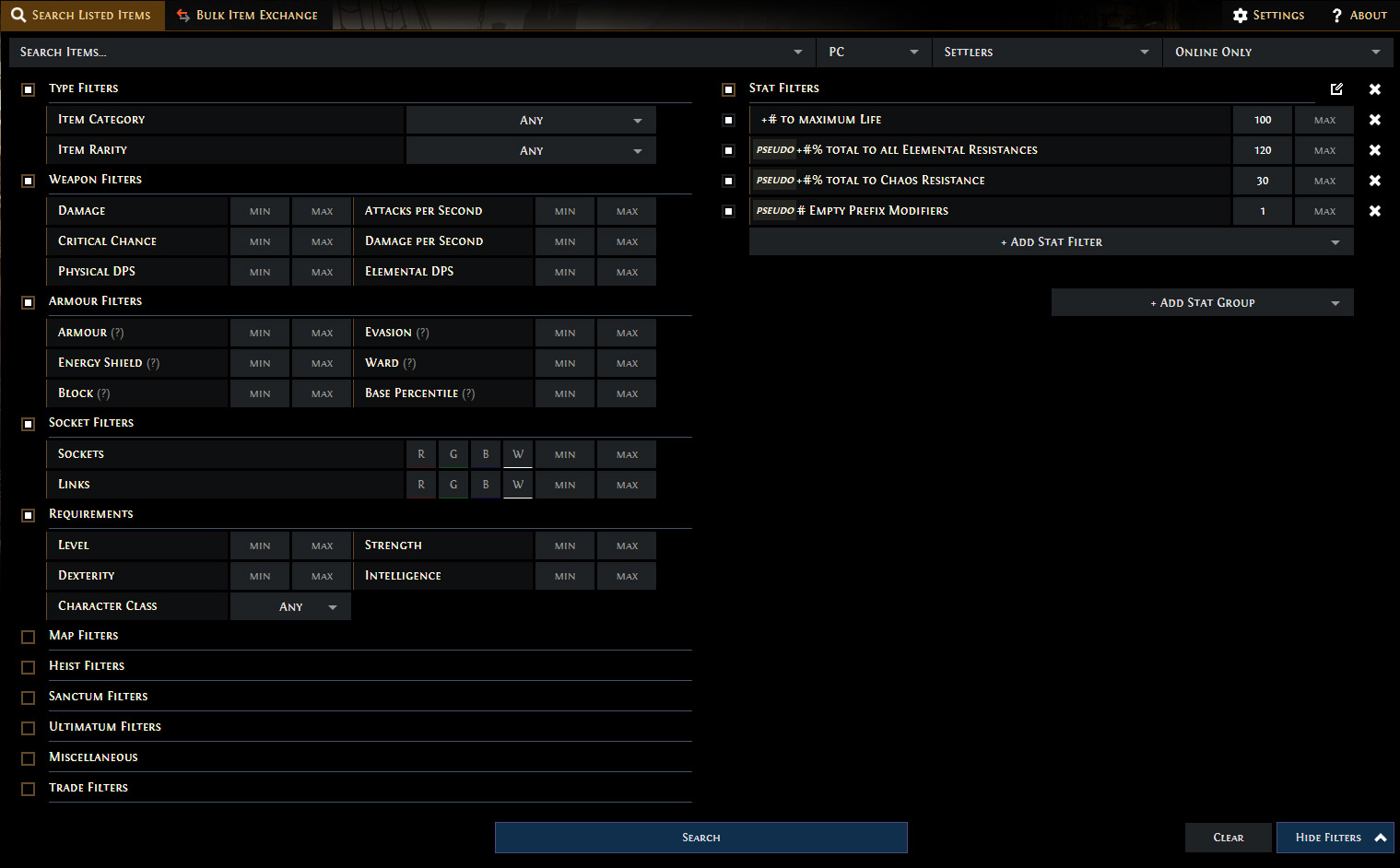
We have also compiled a PoE 2 trading guide for those interested in additional information on this aspect.
As we approach the end of our PoE 2 beginner’s guide, we will explore one of the last aspects a newcomer to the game should know: the end-game and available activities.
Path of Exile 2 end-game activities
Path of Exile 2’s end-game will expand on the predecessor’s intricate systems. Players can explore various activities after completing the campaign, such as maps and new or reworked end-game bosses to challenge their skills. You will even be able to encounter reworked league mechanics from PoE 1, such as Ritual, Breach, Delirium and more.
Considering what we know from Path of Exile 1, we can expect the sky to be the limit when mentioning PoE 2 & end-game in the same sentence. With reworked variants of league mechanics from PoE 1, brand new ones to encounter in maps, and a complete redesign of the boss system, players can mix and match activities as they like, creating a fun and rewarding experience for everyone.
In the upcoming sections, we’ll explore all the end-game activities that players can try out in Path of Exile 2!
Maps
In Path of Exile 2, maps are the entry point into the end-game, with a progressive difficulty system through map tiers, allowing each player to move at their own pace. Maps in PoE 2 are very similar to end-game systems from other games, such as the pit from Diablo 4, echoes from Last Epoch, or even greater rifts from Diablo 3.
In maps, players can find packs of mobs, events known as league mechanics, and a boss at the end of the map. In Path of Exile 2, Waystones which are used to access maps on the Atlas can be modified similarly to items and enhanced using Tablets and currencies like Distilled Emotions.
Bosses
Path of Exile 2’s Pinnacle bosses are designed to challenge even the most seasoned players, testing the skill and power of their build through intense encounters requiring total concentration and attention to come victorious. They come in various difficulty levels, with most bosses having 4 difficulties to choose from.
Testing your skills & the power of your build is not the only reason to challenge these titans of Oriath, as each boss in PoE 2 will be the only drop location of specific unique items. In most cases, these boss-exclusive uniques are way stronger than most items in the game, making every end-game boss a target for these chase items.
Compared to the first game, bosses received a significant overhaul, mainly due to the fewer limitations of the game engine, allowing enemies to be split into multiple moving parts. Due to this major change in PoE 2, we expect new and exciting boss fights that will explore concepts we’ve never seen before in any ARPG.
Other Activities
While maps & bosses are the main end-game activities in PoE 2, we can expect to have a few unique activities as well. In the list below, we will take a quick glance at the other content available to Path of Exile 2 players:
- Trials are the first unique activity players encounter, which has the initial purpose of unlocking ascendancy points. Once players reach the end-game, they can vastly improve the rewards of trial runs by using Relics and Inscribed Ultimatums, essentially allowing Trials to become a break from mapping, while still providing loot through unique gameplay aspects.
- Expedition Logbooks are another unique activity, where players join a group of archeologists, uncovering remains of ancient civilizations using explosives, and defeating the unearthed enemies to obtain the spoils buried alongside them.
FAQ
What is the best build for a beginner in PoE 2?
Choosing the best build for a beginner in PoE 2 is an easy choice. Check out a couple of builds you may enjoy, and simply pick the one that looks the best. In Path of Exile 2 most builds are one-button builds that don’t require complex combos or rotations, so picking something you enjoy should be your top priority.
What is the most beginner friendly class in PoE 2?
While all classes in PoE 2 are created equally, we recommend starting out with a class that can excel using easy-to-craft gear such as the witch or sorceress to have an easier journey through the mid and late game.
Is PoE 2 for beginners?
Path of Exile 2 can seem like a difficult game to get into, with a steep learning curve, but there are many guides and resources out there to assist you and teach you the essentials. If you are willing to learn, we can safely say PoE 2 is for beginners and veterans alike.
What is the best solo starting class in PoE 2?
Based on experience from Path of Exile 1, we expect the Ranger to be one of the strongest solo starting classes in PoE 2. While the early game may be lackluster, and the class requires more complex and optimized gear, it is unmatched in speed and damage at any point in the game.
What is a league starter in PoE 2?
In Path of Exile 2, we call builds optimized for the early game of a new league “league starters.” These builds usually scale poorly into the end-game and are thought out specifically for the first couple of weeks after the release of a new league.
How to pick a class in PoE 2?
Picking a class in Path of Exile 2 comes down solely to personal preference. Every class has powerful builds, and scaling goes to infinity in this innovative ARPG.
What is the best gear to level with in PoE 2?
The best gear to level with in Path of Exile 2 would be a Tabula Rasa paired up with other uniques that provide high resistances and high base damage for the early stages of the game.
What is the best early game farm in PoE 2?
The best farming method for the early game in PoE 2 is alch & go. This strategy relies mainly on the Atlas passive skill tree, and since the investment is minimal, you are guaranteed a small margin of profit for each map you complete.
How to farm currency fast in PoE 2?
If you want to farm currency fast in Path of Exile 2, we recommend keeping up with the latest patch notes and farming strategies players develop. Each league balance change will affect which farm is the most lucrative at the time.
How to get Skill Gems in PoE 2?
The best way to obtain skill gems in PoE 2 is by unlocking the desired skill using an Uncut Gem.
How to level up skill gems in PoE 2?
You can level up skill gems in PoE 2 by using higher level Uncut Gems. Uncut Gem levels are related to the area level in which they drop, so they will naturally increase in level as you progress through the game.
Conclusion
We hope you’ve learned everything you need to get started in your journey as an Exile and familiarized yourself with the game’s systems. Despite the world of Path of Exile 2 and all the different systems seeming complicated at first glance, by playing and keeping yourself informed through guides and videos, you will feel prepared to challenge Oriath’s most formidable foes in no time.

